How serious is the harm of Fukushima Nuclear Sewage ?
- Normal Liver Cells Found to Promote Cancer Metastasis to the Liver
- Nearly 80% Complete Remission: Breakthrough in ADC Anti-Tumor Treatment
- Vaccination Against Common Diseases May Prevent Dementia!
- New Alzheimer’s Disease (AD) Diagnosis and Staging Criteria
- Breakthrough in Alzheimer’s Disease: New Nasal Spray Halts Cognitive Decline by Targeting Toxic Protein
- Can the Tap Water at the Paris Olympics be Drunk Directly?
How serious is the harm of Fukushima Nuclear Sewage ? How it will affect the world environment?
- Should China be held legally responsible for the US’s $18 trillion COVID losses?
- CT Radiation Exposure Linked to Blood Cancer in Children and Adolescents
- FDA has mandated a top-level black box warning for all marketed CAR-T therapies
- Can people with high blood pressure eat peanuts?
- What is the difference between dopamine and dobutamine?
- How long can the patient live after heart stent surgery?
How serious is the harm of Fukushima Nuclear Sewage ? How it will affect the world environment? The whole world will have to stand “nuclear pollution” together, how much do you know about the harm?
On April 13, the Japanese government held a relevant cabinet meeting and formally decided on the policy of discharging nuclear sewage from the Fukushima Daiichi Nuclear Power Plant into the sea, which is harmful to the marine environment, and it is scheduled to start discharge in two years.
According to the report, the nuclear waste water will be diluted to one-fortieth of Japan’s national radiation concentration benchmark value before discharge, which is equivalent to one-seventh of the radiation safety standards for drinking water established by World Health Organization (WHO).
At present, Fukushima Daiichi Nuclear Power Plant produces approximately 140 tons of nuclear sewage every day.
As of April 2021, the nuclear sewage in the storage tanks of nuclear power plants has reached 1.25 million tons.
This decision has aroused fierce repercussions around the world, and major media and social platforms have launched extensive discussions on this issue.
Unexpectedly, among many options, Japan chose to force the world to pay for its nuclear accident.
How does nuclear waste water discharge into the sea affect the world?
TEPCO previously stated that after treatment, most of the radioactive elements in nuclear waste water can be removed, but “tritium” cannot be removed.
They will dilute the tritium concentration in the wastewater to 1/40 of the Japanese national standard and will not pollute the ocean.
However, according to previous reports from the International Atomic Energy Agency and the United Nations Scientific Committee on the Effects of Atomic Energy, the discharge of nuclear waste water from the Fukushima nuclear power plant will have a profound impact on the marine environment, food safety and human health.
However, on April 12, local time, IAEA Director General Grossi expressed his support for the matter and said: “The release process is similar to the wastewater treatment of other factories in the world. At present, efforts should be made to avoid this matter endangering the marine environment, food safety and food safety. human health.”
However, scientists believe that once sewage containing radioactive substances is discharged into the sea, the waters off the Pacific coast of Japan will be affected, especially the local waters around Fukushima Prefecture.
A Japanese scholar pointed out that the ocean around Fukushima is not only a fishing ground for local fishermen to survive, but also a part of the Pacific Ocean and even the global ocean.
The discharge of nuclear sewage into the ocean will affect global fish migration, pelagic fisheries, human health, ecological security, etc. In all respects, this issue is not just a domestic issue in Japan, but an international issue involving global marine ecology and environmental security.
The German Marine Scientific Research Institute pointed out that the coast of Fukushima has the strongest ocean currents in the world.
Within 57 days from the date of discharge, radioactive materials will spread to most of the Pacific Ocean. The United States and Canada will be affected by nuclear pollution three years later. 10 Years later, it spread to the global waters.
Greenpeace nuclear experts pointed out that the carbon 14 contained in Japanese nuclear waste water is dangerous for thousands of years and may cause genetic damage. By then, no one will be able to withdraw from this disaster.
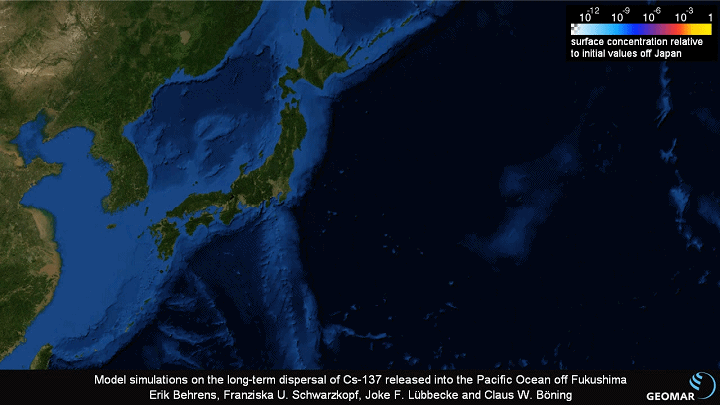
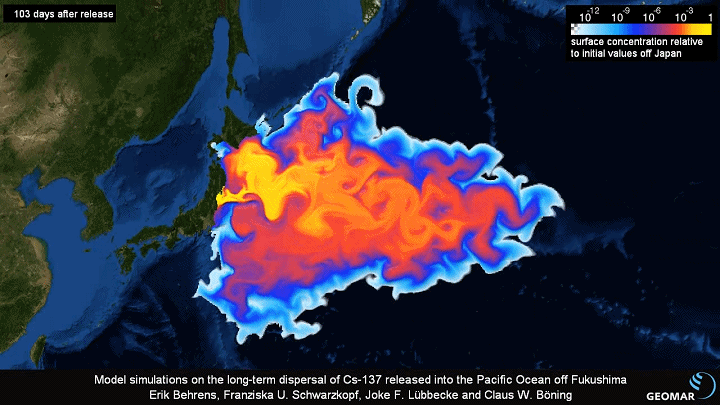
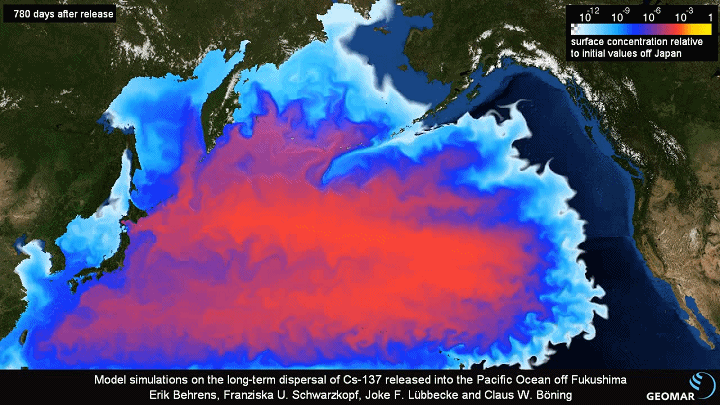
Figure | The simulation effect diagram of German marine scientific research on the diffusion rate and impact of nuclear sewage (photo source: GEOMAR)
Can seafood still be eaten?
According to the “Health Times” citing expert opinions, “Generally speaking, the discharge of nuclear sewage into the sea will affect us.”
United Nations human rights experts also issued a statement on March 11, stating that discharging nuclear waste water into the sea will increase the risk of endangering children’s future health. At the same time, nuclear wastewater will have a significant impact on the marine environment, fishery resources, food safety and human health.
In addition, radioactive materials can affect genes. The radioactive tritium, cesium, strontium, plutonium, carbon and other nuclei that were discharged into the environment after the Fukushima nuclear power plant leaked have a very long half-life, so no one can guarantee that water containing a large number of and multiple radionuclides will affect human health and life, and What is the impact of biological evolution, but at least it can be judged that nuclear pollution of water may cause genetic mutations, and also have a negative impact on marine life and the marine environment, and the impact can last for thousands of years.
By then, humans will indirectly ingest various radioactive isotopes in seawater through the consumption of seafood.
Experiments have proved that long-term and large-scale consumption of radioactive contaminated seafood may cause the accumulation of radioactive substances in the body to exceed the allowable amount, cause chronic radiation sickness and other diseases, and cause damage to the blood organs, endocrine system, and nervous system.
Moreover, ordinary people do not have the ability to distinguish whether seafood is contaminated or not at a conventional level. At that time, we can only rely on professional institutions to test marine products.
How is nuclear sewage produced?
There are three main sources of radioactive waste water from the Fukushima Nuclear Power Plant: the original coolant in the reactor, the water injected to continuously cool the core after the accident, and a large amount of groundwater and rainwater that infiltrated the reactor.
After a radiation leak, in order to control the temperature of the reactor, it is necessary to continuously inject water to cool down. Although nuclear waste water can be used for circulating cooling, because the Fukushima nuclear power plant is near the sea and the terrain is low, groundwater and rainwater continue to infiltrate, so nuclear waste water becomes more and more. The more.
In order to store nuclear sewage, Tokyo Electric Power has prepared a total of about 1,000 water storage tanks, 90% of which are currently full.
The total capacity of all water storage facilities is approximately 1.37 million tons, which is expected to reach its limit in the fall of 2022.
Thousands of densely packed circular water storage tanks are placed in the plant area, which can be clearly observed with satellite images.
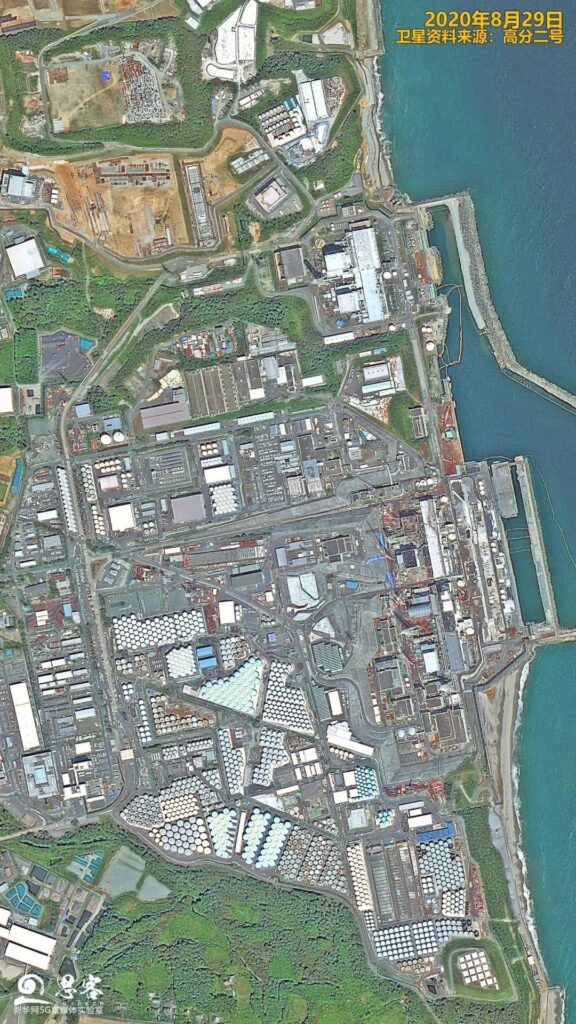
Figure | Fukushima Nuclear Power Plant and its surroundings taken by Gaofen-2 on August 29, 2020 (Source: Xinhuanet, satellite data source: Gaofen-2)
Is there only one road that drains into the ocean?
Since 2013, the Japanese government has proposed five methods for nuclear waste water disposal ,include:
Injection into the stratum, discharge into the ocean, release of steam, release of hydrogen, and underground burial. Whether it is sealed in a tank or injected into the ground, or evaporated into the atmosphere or discharged into the sea, it is essentially a strategy of “giving it to time for processing”.
On the whole, all the processing strategies are more like “cloaking ears and stealing bells”. But in fact, we actually lack the means for nuclear waste.
On April 26, 1986, the No. 4 reactor of the Chernobyl nuclear power plant caught fire and caused an explosion.
The radioactive material produced was 400 times that of the atomic bomb dropped by the United States on Hiroshima, Japan.
The explosion dust drifted away in the wind, causing Russia, Belarus, Ukraine and many places in Europe to suffer from nuclear radiation pollution.
In order to prevent the No. 4 reactor after the Chernobyl nuclear explosion and the “sarcophagus” that covered its nuclear proliferation from continuing to endanger the local area and Europe, the European Union and the European Bank for Reconstruction and Development have launched a new security containment body. Vault-shaped building plan.
The “new safety enclosure” is 152 meters long, 106 meters high, and has a total weight of more than 30,000 tons. It is called an “extraordinary work in engineering”, and it can store harmful substances for a hundred years.
The “new safety containment body” has provided a reference for the treatment of nuclear pollution in Fukushima and the aftermath.
Now, the Japanese civil organization “Nuclear Energy Citizens Committee” believes that “large storage tanks are stored on land” or “solidified with mortar” is an existing method.
The best way to solve the problem of nuclear sewage under technology can ensure that nuclear sewage is properly kept on land.
In fact, according to satellite images, there is a large amount of land available around the Fukushima nuclear power plant.
As a Fortune 500 company, Tokyo Electric Power is not short of money. To them, this seems to be just a question of whether they want it or not.
Review of Fukushima Daiichi Nuclear Power Plant Accident
At 14:46 on March 11, 2011, a magnitude 9.0 earthquake and the subsequent tsunami hit Japan hard. Affected by the major earthquake, the reactor cooling system of the Fukushima Daiichi Nuclear Power Plant failed and radioactive materials leaked.
On the same day, the Japanese government declared a “nuclear energy emergency.” At 16:16 on April 11, another 7.1-magnitude earthquake occurred in Fukushima. Japan once again issued a tsunami warning and a nuclear leak warning.
On April 12, the Japan Nuclear Safety and Security Agency designated the Fukushima nuclear accident as the highest level 7 according to the International Nuclear Incident Classification Scale.
A series of incidents in the accident leaked a large amount of radioactive materials in the surrounding environment, including exhaust pressure relief operations, hydrogen explosion, containment damage, pipeline steam leakage, and cooling water leakage.
There are various theories about the quality of the radioactive material leaked into the atmosphere in the accident.
According to Tokyo Electric Power’s calculations, a total of about 900,000 trillion (9 billion billion) Bq of uranium elements and large-scale releases of iodine-131, cadmium-137 and plutonium-134 were leaked, which is approximately equivalent to the Chernobyl accident 5.2 million trillion. One sixth of Bq.
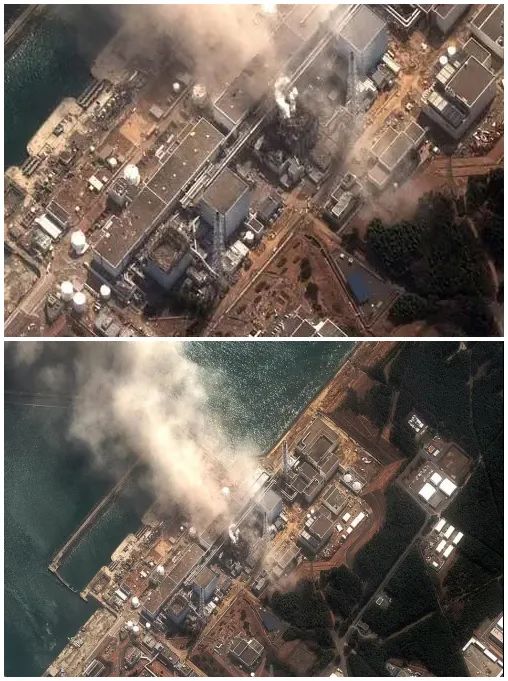 Picture | Smoke after the Fukushima nuclear accident (photo source: Xinhua News Agency)
Picture | Smoke after the Fukushima nuclear accident (photo source: Xinhua News Agency)
In 2012, the Japanese government designated the area within the 20km circle around the Fukushima Daiichi Nuclear Power Plant as a warning zone, and the area with high radiation outside the circle as a “planned evacuation zone”, and a total of about 100,000 residents were evacuated.
In April 2012, according to the radiation level of the area, the area where the evacuation instructions are to be lifted, the restricted residential area, and the difficult area to return to were re-designated. In principle, it is not allowed to enter and return to difficult areas.
On July 22, 2013, two years and several months after the accident, TEPCO stated that radioactive sewage from the nuclear power plant was leaking into the Pacific Ocean.
On August 20, another incident occurred at the nuclear power plant. As many as 300 tons of high-radiation-concentration sewage leaked from the sewage storage tank.
This sewage is enough to endanger the health of nearby employees. On September 3, the Japanese government prepared to invest 47 billion yen to prevent the leakage of sewage, and to build frozen soil walls and decontamination devices.
On October 9, 2013, the staff of the Fukushima Daiichi Nuclear Power Plant leaked about 7 tons of sewage due to misoperation. On November 20th, Tokyo Electric Power Company of Japan carried out sealing operations on the fifth and sixth nuclear reactors of the Fukushima Daiichi Nuclear Power Plant.
In April 2014, some areas gradually lifted their evacuation instructions. In March 2020, all evacuation instructions and restricted residential areas have been lifted, but the evacuation instructions are still maintained except for some areas that are difficult to return to.
On February 22, 2021, the operator of the Fukushima Daiichi Nuclear Power Plant in Japan stated that after the February 13 earthquake off the east coast of Honshu, Japan, the water level inside the storage facility of Unit 1 had dropped. On March 26, inside the nuclear power plant, the staff found signs of a possible nuclear leak.
On April 13, 2021, the Japanese government held a cabinet meeting to formally decide to filter and dilute one million tons of nuclear sewage from the Fukushima Daiichi Nuclear Power Plant into the sea. Discharge will begin in about two years.
Development and review of Fukushima nuclear sewage discharge incident
On September 10, 2019, Japanese Minister of the Environment Yoshiaki Harada said at a press conference in Tokyo, the capital of Japan: “I think there is no choice but to discharge (Fukushima) sewage into the sea to dilute the sewage.” This is the first time. Relevant Japanese officials expressed their stance in the name of “private”.
In February 2020, the relevant committee of the Japanese government responsible for dealing with nuclear wastewater issues issued an assessment report, listing two options for discharge to the ocean and vapor release, and said that from the perspective of comprehensive operation, technology, economy and time factors, the discharge of pollutants into the sea is “more practical.” feasible”. The Japanese side said that the discharge of tritium into the sea has “relatively small” impact on human health.
On January 28, 2021, according to the Japanese Asahi Shimbun, the capacity of nuclear waste water storage tanks in the Fukushima Daiichi Nuclear Power Plant is about to reach its limit, and it is expected to be around the summer of 2022. If there is no better treatment method, 1.37 million tons of nuclear sewage may be directly discharged into the sea.
On April 9, 2021, the Japanese government basically decided to discharge nuclear sewage from the Fukushima Daiichi Nuclear Power Plant into the sea.
On the morning of April 13, 2021, the Japanese government held a relevant cabinet meeting and officially decided to discharge nuclear waste water from the Fukushima Daiichi Nuclear Power Plant to the ocean, which is harmful to the marine environment. Subsequently, NHK stated that TEPCO hopes to start discharging to the sea in two years, and requires specific preparations such as equipment installation.
At 10:15 on April 13, 2021, the US State Department responded that it supported the decision of the Japanese government, stating that the practice “appears to comply with globally recognized nuclear safety standards”. U.S. Secretary of State Blincoln also tweeted, “Thank Japan for its transparent efforts in deciding to dispose of the sewage from the Fukushima Daiichi Nuclear Power Plant. I look forward to the continued coordination between the Japanese government and the International Atomic Energy Agency (IAEA).”
 Figure|Screenshot of the US State Department statement (Source: US State Department)
Figure|Screenshot of the US State Department statement (Source: US State Department)
On the afternoon of April 13, 2021, the South Korean government expressed deep regret on Japan’s decision to discharge nuclear sewage from the Fukushima nuclear power plant into the sea. The head of South Korea’s Office of State Affairs, Goo Yun-cheol, said at the press conference that this behavior poses a threat to the security of neighboring countries and the marine environment, and the South Korean side will not tolerate any measures that may endanger the health of its citizens.
In the end, according to the Tokyo Shimbun, in order to promote the safety of the radioactive tritium contained in the water processed by the Tokyo Electric Power Fukushima Daiichi Nuclear Power Plant, the Agency for Reconstruction of Japan produced and issued a leaflet on the 13th. In this flyer, “Radioactive Tritium” is simulated as a cute character of “mascot”.

How serious is the harm of Fukushima Nuclear Sewage?
(source:internet, reference only)
Disclaimer of medicaltrend.org




4 thoughts on “How serious is the harm of Fukushima Nuclear Sewage ?”
Comments are closed.